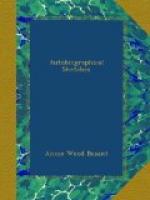Her method of teaching may be of interest to some, who desire to train children with the least pain, and the most enjoyment to the little ones themselves. First, we never used a spelling-book—that torment of the small child—nor an English grammar. But we wrote letters, telling of the things we had seen in our walks, or told again some story we had read; these childish compositions she would read over with us, correcting all faults of spelling, of grammar, of style, of cadence; a clumsy sentence would be read aloud, that we might hear how unmusical it sounded; an error in observation or expression pointed out. Then, as the letters recorded what we had seen the day before, the faculty of observation was drawn out and trained. “Oh, dear! I have nothing to say!” would come from a small child, hanging over a slate. “Did you not go out for a walk yesterday?” Auntie would question. “Yes”, would be sighed out; “but there’s nothing to say about it”. “Nothing to say! And you walked in the lanes for an hour and saw nothing, little No-eyes? You must use your eyes better to-day.” Then there was a very favorite “lesson”, which proved an excellent way of teaching spelling. We used to write out lists of all the words we could think of, which sounded the same but were differently spelt. Thus: “key, quay,” “knight, night,” and so on; and great was the glory of the child who found the largest number. Our French lessons—as the German later—included reading from the very first. On the day on which we began German we began reading Schiller’s “Wilhelm Tell,” and the verbs given to us to copy out were those that had occurred in the reading. We learned much by heart, but always things that in themselves were worthy to be learned. We were never given the dry questions and answers which lazy teachers so much affect. We were taught history by one reading aloud while the others worked—the boys as well as the girls learning the use of the needle. “It’s like a girl to sew,” said a little fellow, indignantly, one day. “It is like a baby to have to run after a girl if you want a button sewn on,” quoth Auntie. Geography was learned by painting skeleton maps—an exercise much delighted in by small fingers—and by putting together puzzle maps, in which countries in the map of a continent, or counties in the map of a country, were always cut out in their proper shapes. I liked big empires in those days; there was a solid satisfaction in putting down Russia, and seeing what a large part of the map was filled up thereby.
The only grammar that we ever learned as grammar was the Latin, and that not until composition had made us familiar with the use of the rules therein given. Auntie had a great horror of children learning by rote things they did not understand, and then fancying they knew them. “What do you mean by that expression, Annie?” she would ask me. After feeble attempts to explain, I would answer: “Indeed, Auntie, I know in my own head, but I can’t explain”. “Then, indeed, Annie, you do not know in your own head, or you could explain, so that I might know in my own head.” And so a healthy habit was fostered of clearness of thought and of expression. The Latin grammar was used because it was more perfect than the modern grammars, and served as a solid foundation for modern languages.




